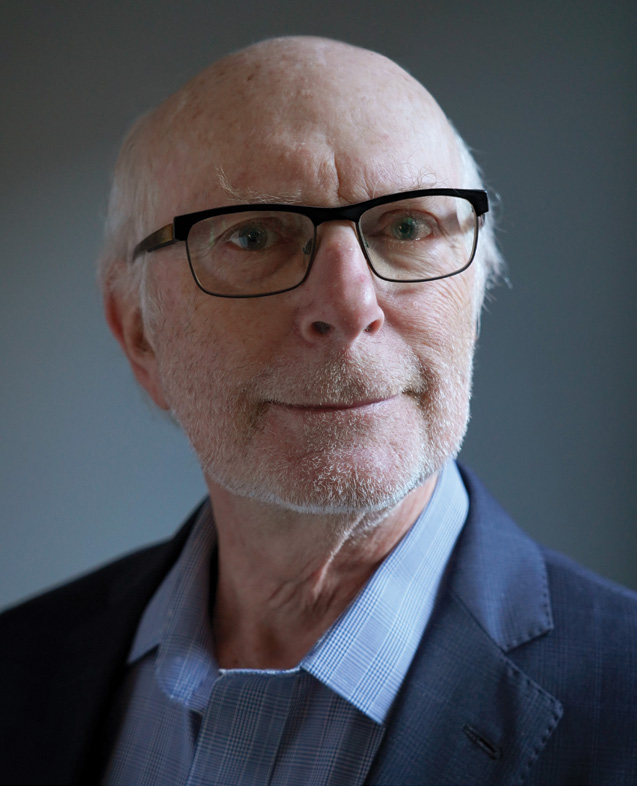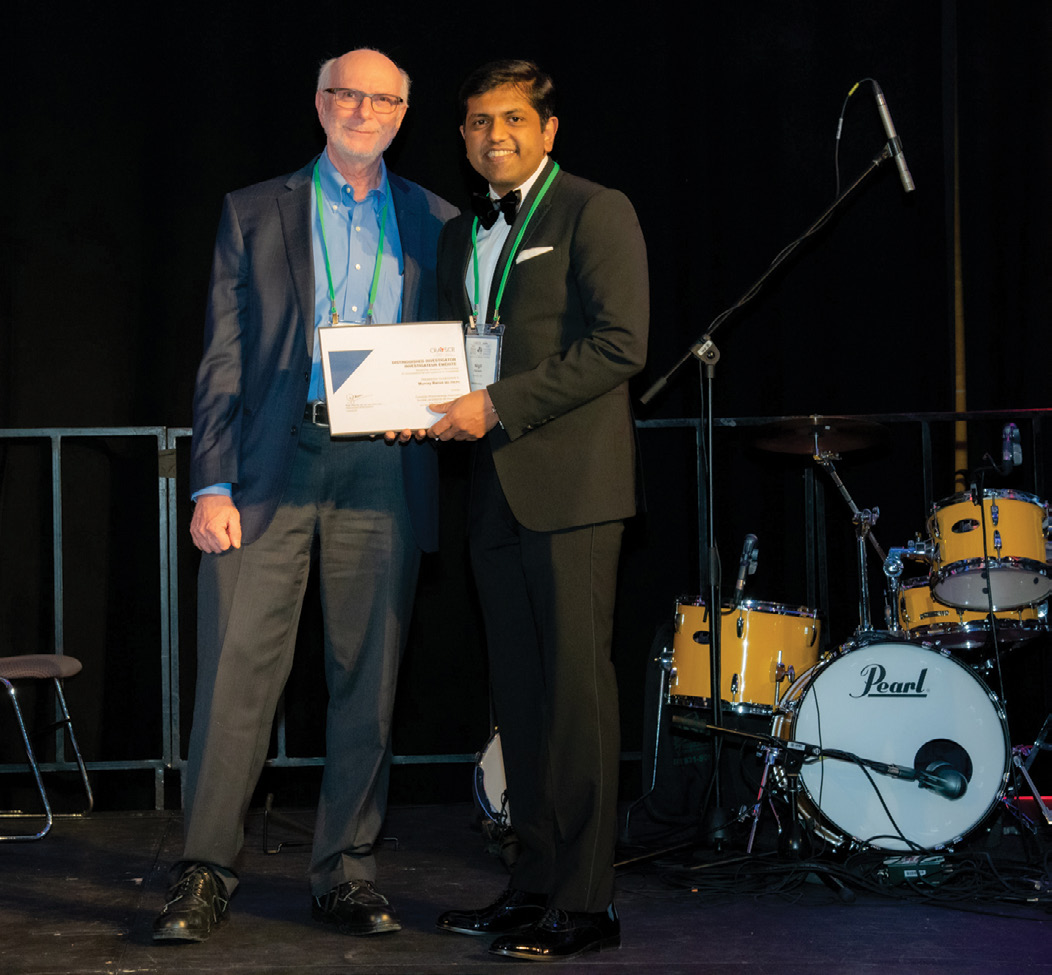Summer 2023 (Volume 33, Number 2)
The CRA's 2023 Distinguished
Investigator: Dr. Murray Baron
Download PDF

What was your first thought when you
learned that you would receive this
award?
I have to say that the feelings associated
with being awarded something like this
are very mixed. This is such an enormous
honour that, of course, it gives me a deep
sense of satisfaction and pride that my
work in research has been recognized. On
the other hand, and I expect that others
have had somewhat similar feelings, it is
an award that I would never have sought
on my own and it left me with a bit of a
feeling that perhaps I don’t really deserve
this.
Nevertheless, I also thought of this
award as perhaps more a recognition of
my leadership of a group of very talented
people whom I have worked with over
the last 20 years. The Canadian Scleroderma Research Group
began with a meeting at the Canadian Rheumatology Association
(CRA) meeting in Quebec City 20 years ago. I cannot
remember exactly all the attendees but many of the eventual
rheumatologists who recruited patients and recorded
data were there, including Sharon LeClercq, Janet Markland,
Janet Pope, David Robinson, Doug Smith, Maysan Abu-Hakima, Peter Docherty, Elzbieta Kaminska, Niall Jones,
Evelyn Sutton, Marie Hudson and Nadir Khalidi. We were
joined in later years by Alena Ikic, Ariel Masetto, Genevieve
Gyger, Maggie Larché and perhaps others I have inadvertently
left out, for which I apologize. And, of course,
Marv Fritzler, who did all our testing for antibodies, stored
all our sera, and offered invaluable advice over many years.
And then there are the over 1,600 patients who donated
their time, personal details, and biospecimens, without
which this research could never have been done.
So, this wonderful award was something that I felt I accepted
on behalf of a very large group.
Why did you become a rheumatologist? What or who
influenced you along the way to do so?
When I did a rotating internship at the Jewish General Hospital
in Montreal in 1972, the chief medical resident — and
also a friend of mine — was Dr. Howard Stein who went into
rheumatology and turned up on staff at St. Paul’s Hospital
in Vancouver when I was there in 1975 doing my internal
medicine residency. I attended his clinics and did a 3-month
rotation at G.F. Strong Rehabilitation Centre. I was impressed
by both the clinical skills required in rheumatology
and the academic aspects of the advances in the rheumatic
diseases and decided that this would become my area
of specialization.
What do you believe are the qualities
of a distinguished investigator?
What a loaded question! I think all investigators
are driven by the excitement of
creating new knowledge. For my research
and that of my colleagues, the idea that
you could create a database of patient information
and suddenly be able to query
all that data and come up with new information
about a serious but rare disease
was just so exciting. It was a “build it and
they will come” situation, where questions
we never even thought of when we
created our registry just popped into our
minds as we looked at the data.
In 1982, you created an inpatient
rheumatic disease unit at the
Jewish Rehabilitation Hospital for
multidisciplinary care of patients. That unit closed about
20 years ago when biologic drugs became available for
rheumatoid arthritis, vastly improving patients’ health and
well-being. Since then, research has become an important
part of your contribution to medicine, and you created the
Canadian Scleroderma Research Group (CSRG) in 2003. Can
you tell us more about this research?
The CSRG research has been multi-pronged but mostly clinically
based, although we have collaborated with several
labs working on serum and skin biopsies. Initially, our work
focused on function and quality of life issues facing our patients.
We showed that our patients suffered very serious
consequences of their disease which could be measured
reliably. This opened the way to determine if function and
quality of life could be improved by interventional trials.
We have continued to focus on outcome measures of the disease.
In collaboration with colleagues in Australia, we have
developed a method to assess the accrual of organ damage
over time and are now working with these same colleagues
on a measure of disease activity. Our data have also been
used in the development of a new endpoint, the Composite
Response Index for Clinical Trials in Early Diffuse Cutaneous
Systemic Sclerosis (CRISS), which is currently being
used in drug trials in SSc and in the development of new
classification criteria for SSs. Three of the four members of
the core committee were Canadians, including myself. We
are also currently working on a measure of the severity of
cardiac involvement in SSc and have also looked at the reliability
and validity of other outcome measures.

Dr. Murray Baron receiving his award from CRA President
Dr. Nigil Haroon at the CRA Annual Scientific Meeting in
Quebec City, which took place in February 2023.
Are there other areas of interest you would like to
investigate in the future? What projects will you be
undertaking in the near future?
We are very interested in doing more work on the damage
index we have created, and the new activity index under development.
We have also launched a large project to try to
better predict the course of lung disease in SSc, which will be
essential to the efficient design of clinical trials of therapies
for that condition, which is a major cause of morbidity and
mortality in SSc. Part of this work has involved collecting
hundreds of lung CT scans that have been performed across
Canada on our patients over the last 20 years. We hope to
be able to use artificial intelligence to read those scans to
allow us to better understand the variables associated with
the worsening of lung disease over time.
You have also been president of the Scleroderma Clinical
Trials Consortium (SCTC) which represents most of the
world’s scleroderma researchers. You have transformed this
group into a vibrant new organization with many working
groups performing research that will improve the efficiency
of scleroderma clinical trials. You are now an executive
member of the organization and run two of the working
groups. Additionally, you also chair a subcommittee that is
working on a white paper for regulatory agencies, including
the FDA, that will make recommendations about outcome
measures for scleroderma therapeutic trials. What is the
greatest professional and organizational challenge you have
faced, and how did you address/overcome this challenge?
Participating in the activities of the SCTC has been one of the
highlights of my time as a researcher. The organization has
been funding projects that aim to improve the efficiency of
clinical trials. If you cannot measure it well, you cannot study
it. This could easily be the motto of the SCTC. The challenge
has been raising the funds to support these research projects.
I created an SCTC-PHARMA roundtable that has raised substantial
money from pharmaceutical companies that has helped
the SCTC support this kind of research, and I am very
content that my input has been able to support that.
What have been the most rewarding aspects of
going into the field of rheumatology and what have
been some of the most challenging aspects?
Rewarding: Helping to improve the quality of life of our patients
and to have been present during the transition from
so-so drugs like gold injections to the very effective biologics.
Frustrating: The slow advances in treating the noninflammatory
diseases like osteoarthritis. Those diseases
make up a very high percentage of rheumatic diseases, and
together account for the major proportion of the morbidity
our patients suffer. Over the 40 years of my clinical practice,
I do not feel we have made any major advances in the treatment
of these conditions. Luckily, there are many highly
qualified researchers in Canada and elsewhere working on
osteoarthritis and, hopefully, that situation will improve.
What is your proudest accomplishment?
The creation of the CSRG and the collaboration with so
many contributors across Canada and elsewhere.
What advice would you give to someone looking to pursue
a career as an academic rheumatologist?
Do it! Canada is an excellent place to do this kind of work
as we have an important tradition of collaboration not present
in every country. Basically, it is important for young potential
investigators to understand that research is fun and
exciting. Creating knowledge is not what we are taught in
medical school. There we learn to use knowledge. I can thus
understand how difficult it is for a trainee to make the leap
from many years of learning how to use knowledge to creating
knowledge instead. Try it out and accept the challenge
because the results are so rewarding!
What is your favourite book of all time?
I am just listening to "Demon Copperhead" by Barbara
Kingsolver and it’s terrific. Not sure I have a single favourite.
I walk to work and listen to books on the way. At home, I do
it the old-fashioned way — reading.
What is your favourite food or cuisine?
Anything my wife cooks. She is a terrific cook. I didn’t have
to say this just in case she reads this. It’s true.
What is your dream vacation destination?
Somewhere the temperature is room temperature, the sky is
clear every day and I can play golf while my wife plays tennis.
How many cups of coffee does it take to make a productive
day?
None. But I do need a Pepsi Zero once a day, so I guess that
covers my caffeine requirement.
Murray Baron, MD, FRCPC
Senior Investigator, Lady Davis Institute
Division of Rheumatology,
Jewish General Hospital
Past Director, Canadian Scleroderma Research Group
Professor of Medicine,
McGill University
Montreal, Quebec
|
